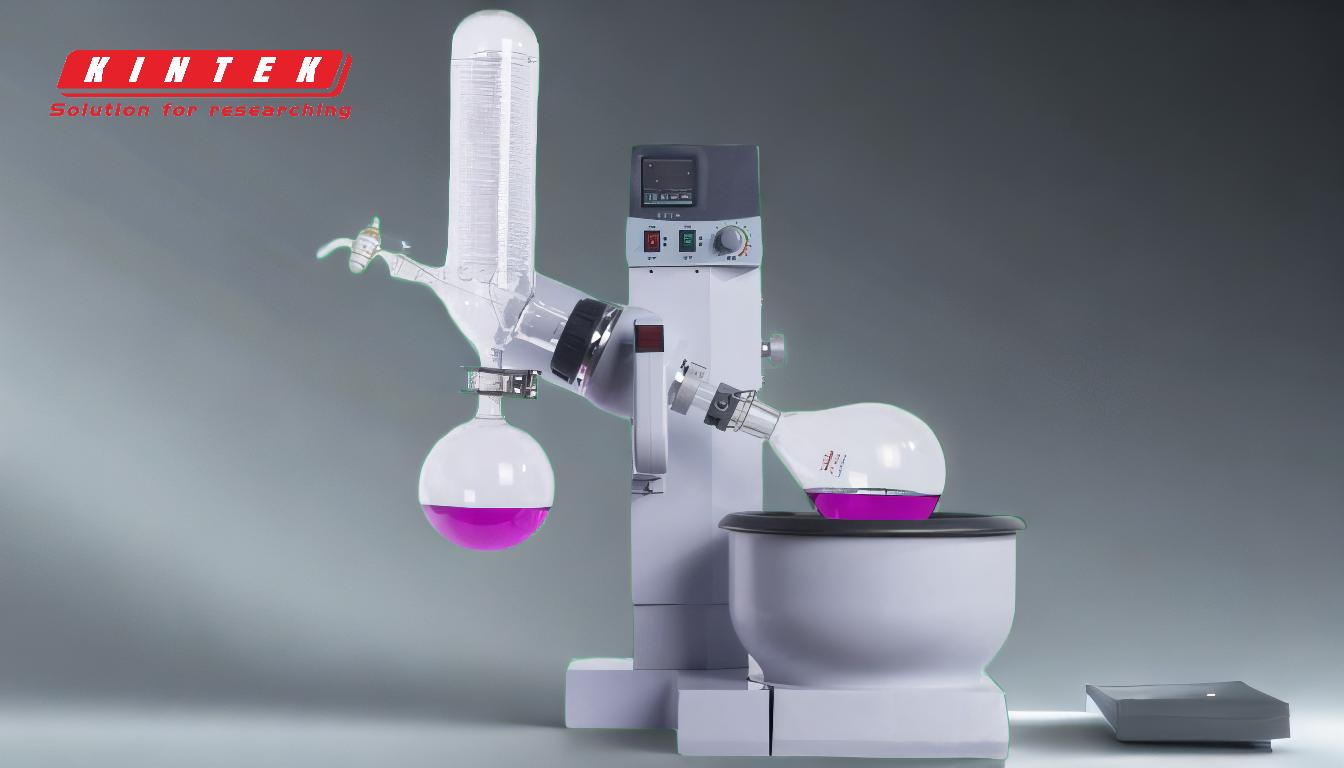A rotary evaporator is a specialized device used in laboratories for solvent removal through a process known as rotary evaporation. This technique involves the use of reduced pressure (vacuum), heat, and mechanical rotation to efficiently evaporate solvents from a sample. The process is particularly effective for separating volatile solvents from less volatile compounds, making it a key tool in applications such as concentration, crystallization, and solvent recovery. Rotary evaporation is widely used in industries like pharmaceuticals, chemistry, and food production due to its ability to handle large volumes of solvents at lower temperatures, preserving the integrity of heat-sensitive compounds.
Key Points Explained:

-
Definition of Rotary Evaporation:
- Rotary evaporation is a gentle distillation technique used to remove solvents from a sample under reduced pressure. It combines heat, vacuum, and mechanical rotation to enhance the evaporation process.
- The process is particularly suited for volatile solvents, as it lowers their boiling points, allowing evaporation at lower temperatures and minimizing the risk of degrading heat-sensitive compounds.
-
How a Rotary Evaporator Works:
- Reduced Pressure (Vacuum): A vacuum pump or water aspirator reduces the pressure inside the system, lowering the boiling point of the solvent. This enables evaporation at temperatures lower than the solvent's normal boiling point.
- Rotation: The sample flask is rotated to create a thin film of the solvent on the inner surface of the flask. This increases the surface area of the liquid, accelerating the rate of evaporation.
- Heating: A heated water bath provides controlled heat to the rotating flask, further aiding the evaporation process.
- Condensation: The evaporated solvent vapor travels into a condenser, where it is cooled and condensed back into liquid form. The condensed solvent is collected in a separate receiving flask, while the concentrated compound remains in the original flask.
-
Key Components of a Rotary Evaporator:
- Rotating Flask: A round-bottomed flask that holds the sample and rotates to increase the solvent's surface area.
- Water Bath: Provides controlled heating to the flask, ensuring gentle and uniform evaporation.
- Vacuum System: Reduces the pressure in the system, lowering the boiling point of the solvent.
- Condenser: Cools the solvent vapor, converting it back into liquid for collection.
- Receiving Flask: Collects the condensed solvent, separating it from the concentrated sample.
-
Advantages of Rotary Evaporation:
- Efficiency: The combination of reduced pressure, heat, and rotation ensures rapid and efficient solvent removal.
- Gentle Process: Lower evaporation temperatures protect heat-sensitive compounds from degradation.
- Versatility: Suitable for a wide range of solvents and applications, including concentration, crystallization, and solvent recovery.
- Scalability: Can handle both small-scale laboratory experiments and larger pilot-scale production.
-
Applications of Rotary Evaporation:
- Pharmaceuticals: Used for drug purification, solvent recovery, and concentration of active pharmaceutical ingredients (APIs).
- Chemistry: Essential for synthesizing and isolating chemical compounds.
- Food Industry: Applied in the extraction and concentration of flavors, fragrances, and essential oils.
- Environmental Analysis: Used to concentrate samples for trace analysis of pollutants.
-
Comparison with Other Distillation Techniques:
- Simple Distillation: Unlike simple distillation, which relies on boiling point differences at atmospheric pressure, rotary evaporation operates under reduced pressure, making it more suitable for heat-sensitive compounds.
- Vacuum Distillation: While both techniques use reduced pressure, rotary evaporation incorporates rotation to enhance evaporation efficiency, making it faster and more effective for solvent removal.
-
Considerations for Equipment Purchase:
- Vacuum Pump Performance: Ensure the vacuum pump can achieve the required pressure levels for the solvents being used.
- Heating Capacity: The water bath should provide precise temperature control to avoid overheating sensitive samples.
- Condenser Efficiency: A high-performance condenser ensures effective recovery of solvents.
- Ease of Use: Look for features like automated rotation speed control and easy disassembly for cleaning.
By understanding the principles and components of rotary evaporation, purchasers can select the right equipment tailored to their specific needs, ensuring efficient and reliable solvent removal in their laboratory or industrial processes.
Summary Table:
| Aspect | Details |
|---|---|
| Process | Combines vacuum, heat, and rotation for gentle solvent removal. |
| Key Components | Rotating flask, water bath, vacuum system, condenser, receiving flask. |
| Advantages | Efficient, gentle on heat-sensitive compounds, versatile, scalable. |
| Applications | Pharmaceuticals, chemistry, food industry, environmental analysis. |
| Comparison | More efficient than simple distillation, faster than vacuum distillation. |
| Purchase Considerations | Vacuum pump performance, heating capacity, condenser efficiency, ease of use. |
Ready to enhance your lab's efficiency with a rotary evaporator? Contact us today to find the perfect solution!










